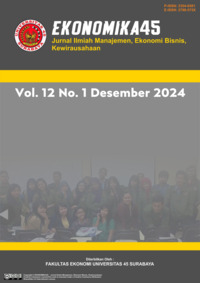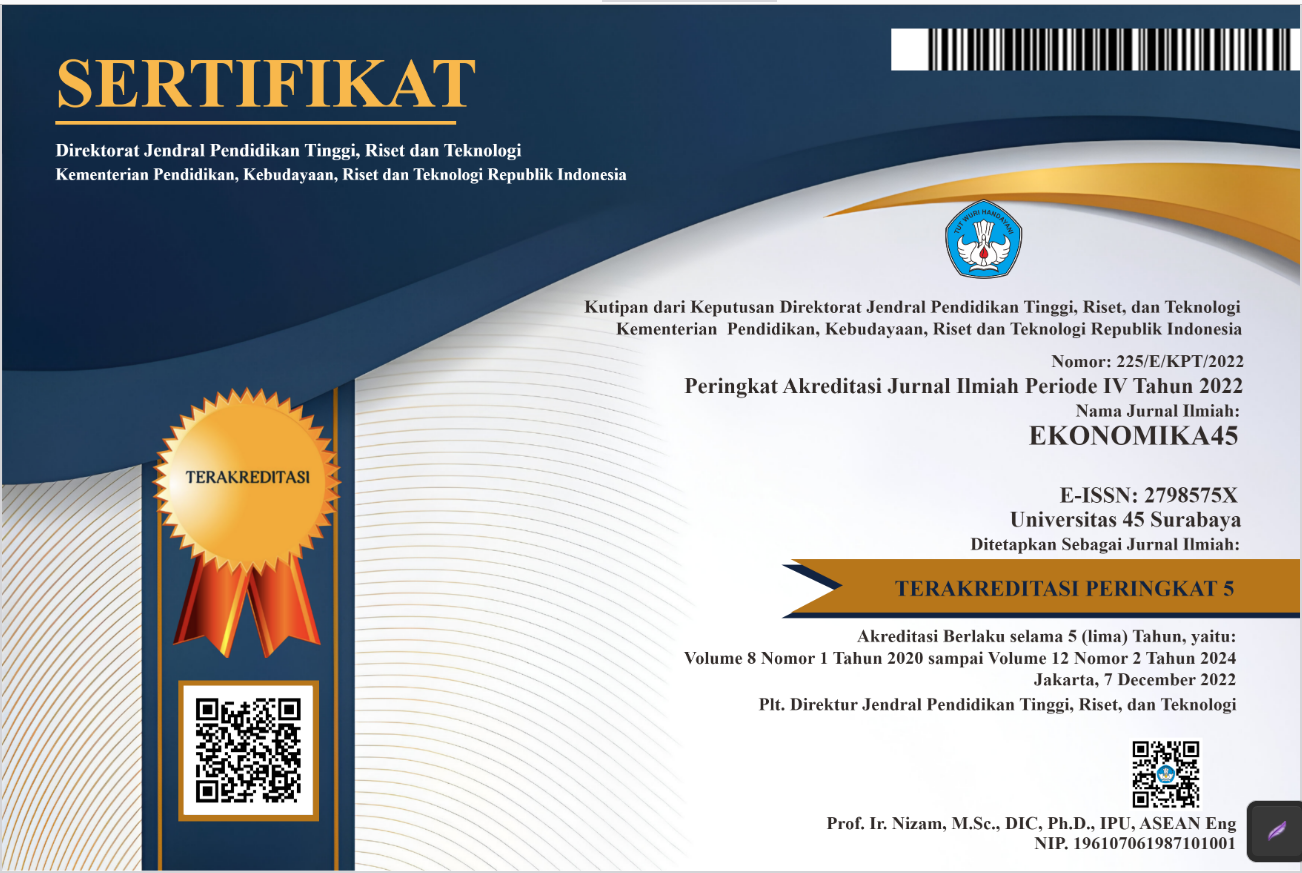Pengaruh Sikap Generasi Milenial dan Generasi Z terhadap Kecenderungan untuk Terus Menggunakan Teknologi Kecerdasan Buatan
DOI:
https://doi.org/10.30640/ekonomika45.v12i1.3567Keywords:
Artificial Intelligence, GAAI, Continuance Intention, Millenials, Generation ZAbstract
This study aims to investigate the influence of millennials' and generation Z's attitudes on their intention to continue using artificial intelligence (AI) technology. Data was collected through a questionnaire distributed online to individuals working in various fields of work that use AI in their activities. A total of 140 questionnaires were returned, exceeding the minimum sample size requested. Data processing involved validity and reliability tests, classical assumption tests, and regression tests. The results showed that millennials tend to have a skeptical attitude towards AI capabilities, while generation Z is more open to the use of AI in various aspects of life. Regression analysis showed that a positive attitude towards AI significantly influences the intention to continue using the technology. The study also revealed that human happiness is more related to human aspects than the use of AI technology. As such, the findings provide valuable insights into the complexity of human interactions with AI and the implications for future technology adoption.
References
Ajzen, I. (1991). The theory of planned behavior. Organizational Behavior and Human Decision Processes, 50(2), 179–211. https://doi.org/10.1016/0749-5978(91)90020-t
Alkhalifa, E., & Lamia, N. (2021). Closing the gap: Why common-sense reasoning still eludes AI. Communications of the ACM, 64(6), 58-67.
Al-Sharafi, M. A., Al-Emran, M., Arpaci, I., Iahad, N. A., AlQudah, A. A., Iranmanesh, M., & Al-Qaysi, N. (2023). Generation Z use of artificial intelligence products and its impact on environmental sustainability: A cross-cultural comparison. Computers in Human Behavior, 143, 107708.
Aziz Sholeh, Abdul et al. (2024). Kompensasi terhadap motivasi kerja karyawan pada PT. Insolent Raya di Surabaya. Journal of Management and Creative Business, 2(1), 82-96.
Cho, S.-A., & Jeon, Y. J. J. (2023, March 28). The decision-making process regarding the continuance intention of using branded apps: An integrated approach to the PAM and the TPB. International Journal of Contemporary Hospitality Management.
De Barros Neto, J. P., & de Oliveira, L. P. (2023a). Study on the perception of Generation Z in relation to robotized selection processes. International Robotics & Automation Journal, 9(3), 99–107. https://doi.org/10.15406/iratj.2023.09.00271
DeVellis, R. F. (2016). Scale Development: Theory and Applications (4th ed.). Sage Publications.
Field, A. (2018). Discovering statistics using IBM SPSS statistics: North American edition. SAGE.
Ghozali, I. (2006). Aplikasi analisis multivariate dengan program IBM SPSS. Badan Penerbit Universitas Diponegoro.
Hair, J. F., et al. (2014). Multivariate Data Analysis (7th ed.). Pearson Education.
Hair, J. F., Risher, J. J., Sarstedt, M., & Ringle, C. M. (2019). When to use and how to report the results of PLS-SEM. European Business Review, 31(1), 2–24. https://doi.org/10.1108/EBR-11-2018-0203
Harlan, W. R. (2016). Reliabilitas dan validitas penelitian kualitatif. Jurnal Manajemen Pemasaran, 10(1), 28-37.
Javaid, M., Halim, A., & Singh, R. P. (2023a). A study on ChatGPT for Industry 4.0: Background, potentials, challenges, and eventualities. Retrieved from https://www.sciencedirect.com/science/article/pii/S2949948823000033
Jobin, A., Ienca, M., & Vayena, E. (2019). Artificial intelligence: the global landscape of ethics. Nature Electronics, 2(10), 509-519.
Komalasari, K. (2013). Analisis Regresi Linier Berganda: Asumsi Klasik dan Interpretasi Koefisien Regresi. Deepublish.
Komalasari, K., et al. (2022). Prinsip character of a leader pada Generasi Z. PHILANTHROPY: Journal of Psychology, 6(1), 77. https://doi.org/10.26623/philanthropy.v6i1.4960
Kristiawati, et al. (2019). Citra merek persepsi harga dan nilai pelanggan terhadap keputusan pembelian pada Mini Market Indomaret Lontar Surabaya. Jurnal Ilmu Ekonomi dan Manajemen (JMM 17), 6(2), 27-36.
Kumala Dewi, I., et al. (2022). Peningkatan kinerja UMKM melalui pengelolaan keuangan. Jurnal Ekonomi Akuntansi, UNTAG Surabaya, 23-36.
Li, L., Wang, Q., & Li, J. (2022, October 26). Examining continuance intention of online learning during COVID-19 pandemic: Incorporating the theory of planned behavior into the expectation–confirmation model. Frontiers. https://www.frontiersin.org/journals/psychology/articles/10.3389/fpsyg.2022.1046407/full
Likert, R. (1932). A technique for the measurement of attitudes. Archives of Psychology, 22(140), 1-55.
Manyika, J., et al. (2017). What the future of work will mean for jobs, skills, and wages. McKinsey Global Institute.
McKinsey Global Institute. (2017). Artificial intelligence: The next digital frontier? Discussion paper. McKinsey & Company.
Mohammed, Z. (2019). Artificial intelligence definition, ethics, and standards. Retrieved from https://www.researchgate.net/publication/332548325_Artificial_Intelligence_Definition_Ethics_and_Standards
Montemayor, C., Halpern, J., & Fairweather, A. (2022). In principle obstacles for empathic AI: Why we can’t replace human empathy in healthcare. AI & Society. Retrieved from https://www.ncbi.nlm.nih.gov/pmc/articles/PMC8149918/
P;, S. A. (n.d.). Initial validation of the general attitudes towards artificial intelligence scale. Computers in Human Behavior Reports. Retrieved from https://pubmed.ncbi.nlm.nih.gov/34235291
Poola, I., & Božić, V. (2017). How artificial intelligence is impacting real life every day. Retrieved from https://www.researchgate.net/publication/321348028_How_Artificial_Intelligence_in_Impacting_Real_Life_Every_day
Russell, S. J. (2016). Artificial Intelligence: A modern approach. Pearson.
Salim Gazali, et al. (2024). Ikan Nomei, Merdeka Belajar Kampus Merdeka, 1-98.
Schepman, A., & Rodway, P. (2022). The general attitudes towards artificial intelligence scale (GAAI): Confirmatory validation and associations with personality, corporate distrust, and general trust. International Journal of Human–Computer Interaction, 39(13), 2724–2741. https://doi.org/10.1080/10447318.2022.2085400
Shao, T., et al. (2021). Industrial artificial intelligence: Application, challenges, and future outlook. Journal of Ambient Intelligence and Humanized Computing, 1-13.
Shih, W. (2020). Voice revolution. Library Technology Reports. Retrieved from https://journals.ala.org/index.php/ltr/article/view/7361/10126
Song, H. G., & Jo, H. (2023, February 7). Understanding the continuance intention of omnichannel: Combining TAM and TPB. MDPI. Retrieved from https://www.mdpi.com/2071-1050/15/4/3039
Sugiyono. (2015). Statistika untuk penelitian. CV Alfabeta.
Sultan, S. (2021). Limitations of artificial intelligence. Retrieved from https://repository.rit.edu/cgi/viewcontent.cgi?article=12113&context=theses
Sutrisna, C. (2021a). Aspek hukum perlindungan data pribadi dan kondisi darurat kebocoran. Retrieved from https://www.neliti.com/id/publications/549227/aspek-hukum-perlindungan-data-pribadi-dan-kondisi-darurat-kebocoran-atas-data-pr
Tabachnick, B. G., & Fidell, L. S. (2022). Using multivariate statistics. Pearson India Education Services.
Wang, Y., & Yang, J. (2021). How artificial intelligence shapes human happiness: A qualitative study. Journal of Artificial Intelligence and Social Science, 2(1), 12-20.
Downloads
Published
How to Cite
Issue
Section
License
Copyright (c) 2024 EKONOMIKA45 : Jurnal Ilmiah Manajemen, Ekonomi Bisnis, Kewirausahaan

This work is licensed under a Creative Commons Attribution-ShareAlike 4.0 International License.









